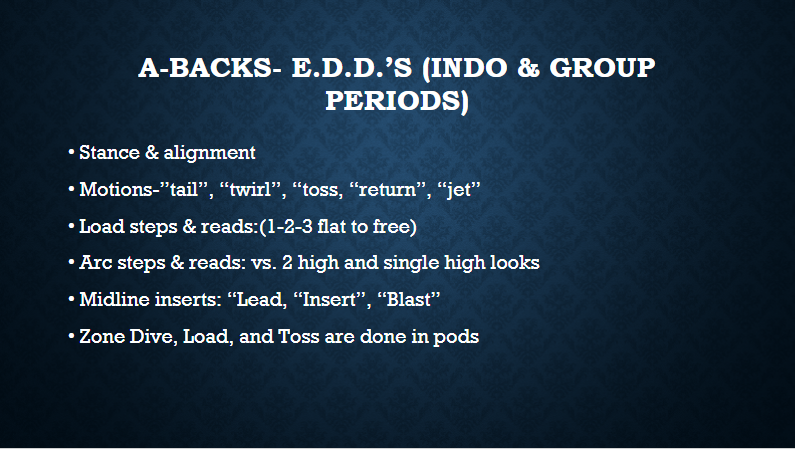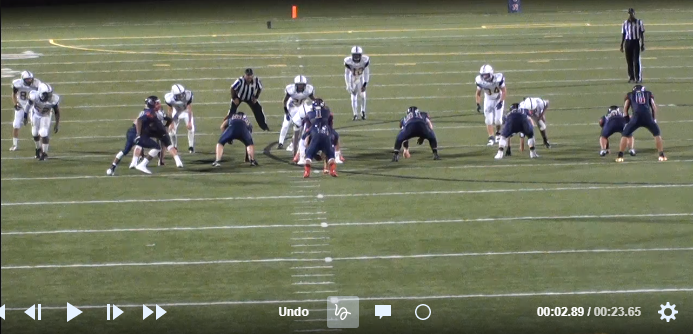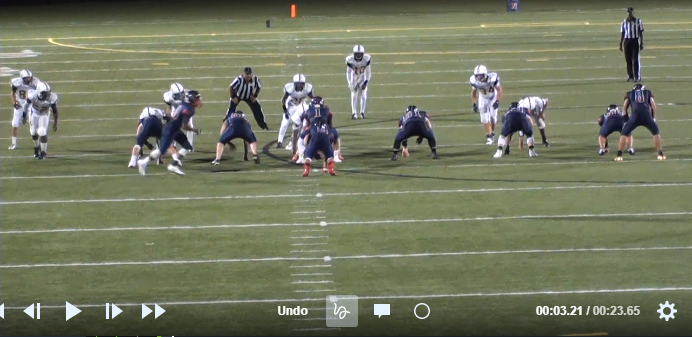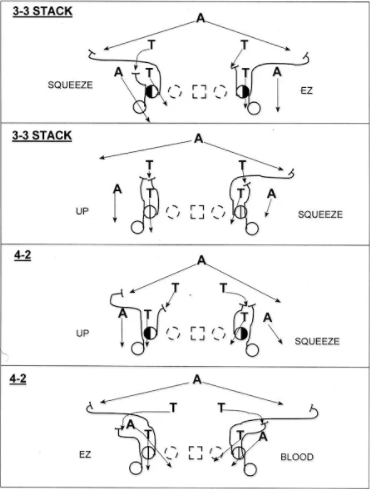Individual Skills and Drills in the Option Practice (A Backs)
I my previous posts we have discussed more group and team concepts. I wanted to take the time to circle back and discuss individual skills and fundamentals that are essential in preparing players for option football. Let’s start discussing A back fundamentals.
We have one coach that works with the A backs. We feel that to really work on the details of this offense we need a separate A backs coach and not a full backfield coach. Some programs have a coach for each backfield position, which is awesome.
The first individual period is stance and alignment. The A back should have his feet a little less than shoulder width apart. We stagger our feet, toe to instep, and our inside foot is back. Their shoulders are square to the line of scrimmage. We fold our hands at our waistband and have a good bend in our ankles, knees and hips. Our alignment is traditional, in that our inside foot is aligned on the outside foot of the playside tackle. You will find in your research that some schools have deepened their A backs off the ball and aligned them right behind the tackle. This alignment helps with consistencies in motioning and cuts down on the steps it takes to get into pitch phase. It also easily declares the A backs in the core formation and in the backfield for rules purposes. You decide what fits your schemes the best and work it everyday.
The next individual period works all the first steps for all the motions we have. We work form our base alignments first and we try to make sure we teach proper footwork for each motion. The first thing you want to do is teach the A backs when to start their motion. We use a three word rhythmic cadence: ready, blue, sethit. We teach our A backs to leave on the echo of blue. Once mastered, we move to teaching proper footwork. A back starting footwork is essential for all motions, the A backs need to press off their outside foot rolling their backside knee towards to ground and opening their playside hip using a 6 inch jab step right at the B back. The second step must be flat at the hands of the B back and almost crossover but not quite. The third step should be at the near hip of the B back and then work flat and fast to get into pitch phase. We emphasize a few points as the A back is moving. The first emphasis is to look at the QB during motion, once the snap occurs. This allows the A back to see the QB disengage and get vertical replacing #1, which means the A back needs to get vertical as well, maintaining proper pitch relationship. Also, if #2 is hot to the QB, looking at the QB allows the A back to prepare for the pitch quicker. The second thing we emphasize is for the A back, while in motion, is to verbally communicate “Ball,Ball,Ball”. This provides a verbal cue for the QB to know where the A back is without actually seeing him at first, and gives confidence to the QB that he is there to be pitched to.
1st Step
2nd Step
3rd Step
We typically work Load blocks with the A backs and tackles in a pod drill but the A backs have to know the proper footwork and positioning, so we teach them that in individual. The load steps are as follows: first step with inside foot starts to clear #1, coaching points are to “Steal the Change” of #1 as you go, to focus on being tight to #1’s outside hip. The second step and third step are vertical steps and the A back must get his eyes on the playside linebacker. After the third step the A back processes where the playside linebacker is fitting on the inside veer play. If the linebacker is scraping to the alley, the A back must block him, by putting his near shoulder on the linebacker’s near hip and running his feet through contact, preventing the playside linebacker from getting into the alley. If the linebacker steps up to attack an inside gap the the A back must get flat off his third step out into the alley to block the free safety or middle of the field defender. The illustration below shows the proper block angles and the looks we give in indivisual and load pod.
Arc steps and reads can be subjective. We dictate to the players the perimeter blocking schemes and rep them accordingly. Some coaches teach the A backs to read the blocks as they release and give them post snap cues to look for. For us, we work perimeter blocking in a 10 in drill session each day. The QB/B/A/WR work this drill together and we provide reads for the QB and vary perimeter looks for the A backs and WR. We work one side at a time to focus on the fundamentals of each block and read. We have developed hand signals for the perimeter looks on defense to make sure the drill moves smoothly. This is a great drill to work play timing, perimeter blocking, and QB reads.
I have added a video to demonstrate each version of midline insert blocks for the A backs. If you have questions let me know. Finally, I'm sure many of you are asking when do you get pass catching and route running for the A backs? The answer is, 7 on 7 / Perimeter run drills and route additions to individual and group sessions. We rotate the A backs to WR route drills sometimes and other times we add passing to the perimeter blocking drills.
For all other A back drills please click on this link for more video clips: https://www.youtube.com/watch?v=WF1L-cV_duk
Our next blog post will continue with WR Indy Drills and as always feel free to discuss blog posts or ask questions on our forum page located here: http://flexbonenation.proboards.com/ If you have any questions please feel free to contact me on twitter @runthetriple or my email address lafayettefootball1@gmail.com
I wish you all the best,
Matt McLeod





